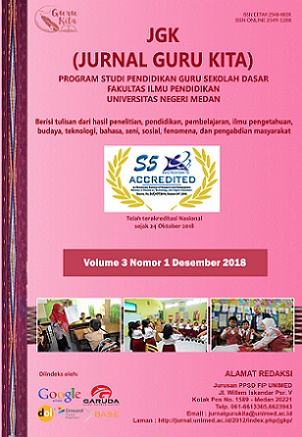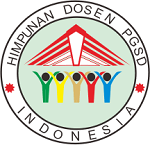MENINGKATKAN KEMAMPUAN MENYELESAIKAN SOAL CERITA DENGAN MENGGUNAKAN MODEL PEMBELAJARAN REALISTIC MATHEMATIC EDUCATION (RME) PADA MATA PELAJARAN MATEMATIKA DI KELAS V SDN 101769 TEMBUNG
DOI:
https://doi.org/10.24114/jgk.v3i4.15091Abstract
Abstract: Improving Ability to Complete the Problem of the Story by Using the Realistic Mathematic Education (RME) Learning Model in Mathematics Learning at Class V SDN 101769 Tembung. The purpose of this study was to determine the increase in the ability to solve story problems in mathematics using the Realistic Mathematic Education (RME) learning model on the multiplication and fraction division material in VB class SD Negeri 101769 Tembung. This type of research is classroom action research with 32 research subjects in Class V SD Negeri 101769 Tembung. The results of data analysis of 32 students obtained a significant increase from the initial test to posttest I and followed up in the second cycle with the acquisition of the ability to solve story questions for the very low category of 2 students (6.25%), low category 1 student (3.125% ), the medium category was 4 students (12.5%), the high category was 6 students (18.75%), and the very high category was 19 students (59.375%), with a claxical average of 87.87. Based on the results of the above analysis it can be concluded that using the Realistic Mathematic Education (RME) learning model can improve the ability to solve story problems in mathematics subjects in class V SD Negeri 101769 Tembung.Keyword: Ability to Solve Story Problems, Fractions, Realistic Mathematic EducationAbstrak: Meningkatkan Kemampuan Menyelesaikan Soal Cerita Dengan Menggunakan Model Pembelajaran Realistic Mathematic Education (RME) Pada Mata Pelajaran Matematika di Kelas V SDN 101769 Tembung. Tujuan penelitian ini adalah untuk mengetahui peningkatan kemampuan menyelesaikan soal cerita pada mata pelajaran matematika dengan menggunakan model pembelajaran Realistic Mathematic Education (RME) pada materi perkalian dan pembagian pecahan di kelas VB SD Negeri 101769 Tembung. Jenis penelitian ini adalah penelitian tindakan kelas dengan subjek penelitian 32 siswa Kelas V SD Negeri 101769 Tembung. Hasil analisis data dari 32 siswa diperoleh tedapat peningkatan secara signifikan dari tes awal ke posttest I dan ditindaklanjuti pada siklus II dengan perolehan nilai kemampuan menyelesaikan soal cerita untuk kategori sangat rendah sebanyak 2 siswa (6,25%), kategori rendah 1 siswa (3,125%), kategori sedang 4 siswa (12,5%), kategori tinggi 6 siswa (18,75%), dan kategori sangat tinggi 19 siswa (59,375%), dengan rata-rata klaksikal sebesar 87,87. Berdasarkan hasil analisis di atas dapat disimpulkan bahwa dengan menggunakan model pembelajaran Realistic Mathematic Education (RME) dapat meningkatkan kemampuan menyelesaikan soal cerita pada mata pelajaran matematika di kelas V SD Negeri 101769 Tembung.Kata Kunci: Kemampuan Menyelesaikan Soal Cerita, Pecahan, RealisticMathematic EducationDownloads
Published
2019-09-20
How to Cite
Ulfa, D., & Anwar, K. (2019). MENINGKATKAN KEMAMPUAN MENYELESAIKAN SOAL CERITA DENGAN MENGGUNAKAN MODEL PEMBELAJARAN REALISTIC MATHEMATIC EDUCATION (RME) PADA MATA PELAJARAN MATEMATIKA DI KELAS V SDN 101769 TEMBUNG. JGK (Jurnal Guru Kita), 3(4), 363–371. https://doi.org/10.24114/jgk.v3i4.15091
Issue
Section
Articles
License
Authors published with the JGK (Jurnal Guru Kita) agree to the following terms:
- Authors retain copyright and grant the journal the right of first publication with the work simultaneously licensed under a Creative Commons Attribution License (CC BY-SA 4.0) that allows others to share the work with an acknowledgment of the work's authorship and initial publication in this journal.
- Authors are able to enter into separate, additional contractual arrangements for the non-exclusive distribution of the journal's published version of the work (e.g., post it to an institutional repository or publish it in a book), with an acknowledgment of its initial publication in this journal.
- Authors are permitted and encouraged to post their work online (e.g., in institutional repositories or on their website) prior to and during the submission process, as it can lead to productive exchanges, as well as earlier and greater citation of published work. (See The Effect of Open Access)




























